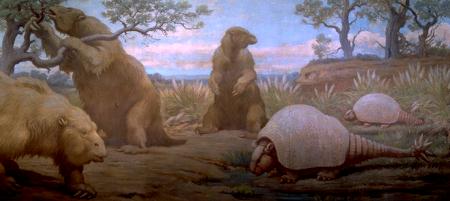
 |
 |
This sloth is eating from a C3 photosynthetic plant. |
Coprolites are not the only way to study what dead animals ate. Carbon isotope studies of teeth and bone can be used to identify whether an animal was herbivorous or carnivorous, what plants it may have eaten, or whether an animal was marine or terrestrial (Barrick, 1998.) Quade et al., 1992; Cerling et al., 1993; MacFadden et al., 1994, 1996 have used stable carbon isotope studies to show the spread of grasslands in the Miocene (Barrick, 1998) |
|
|
||||||||||||||||||||||||||||||||||||||||||||||||||||
Fossil Teleoceras preserved in volcanic ash. Photo from Dott and Prothero, (1994) |
|
|
||||||||||||||||||||
|
|
||||||||||||||||||||
|
|
||||||||||||||||||||||||||||||||
| [Home] [Oxygen] [Carbon] [Strontium] [Limitations] [References] |